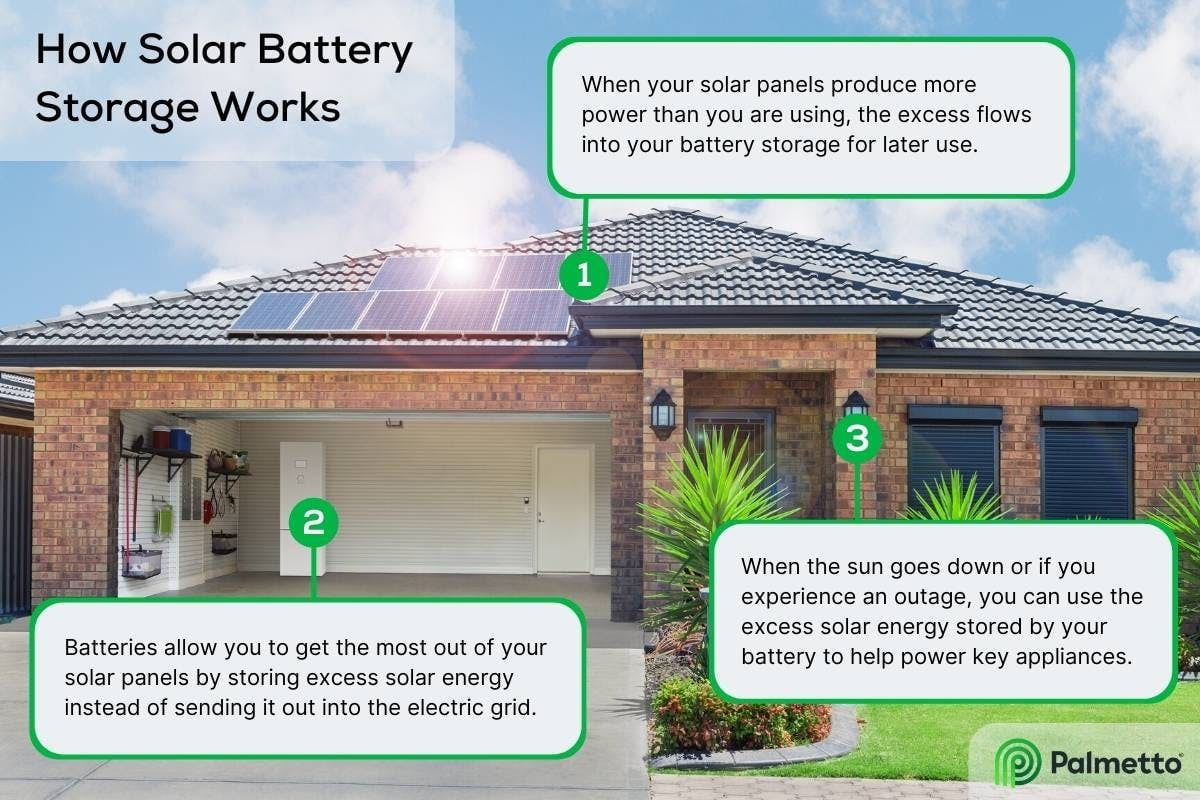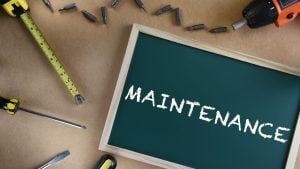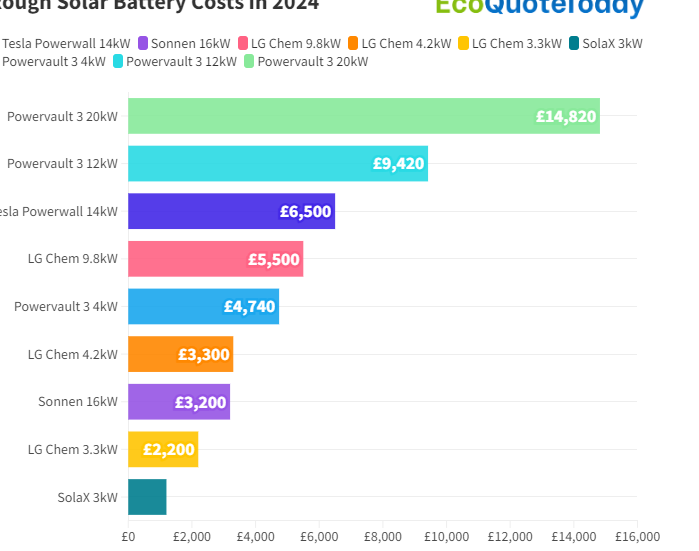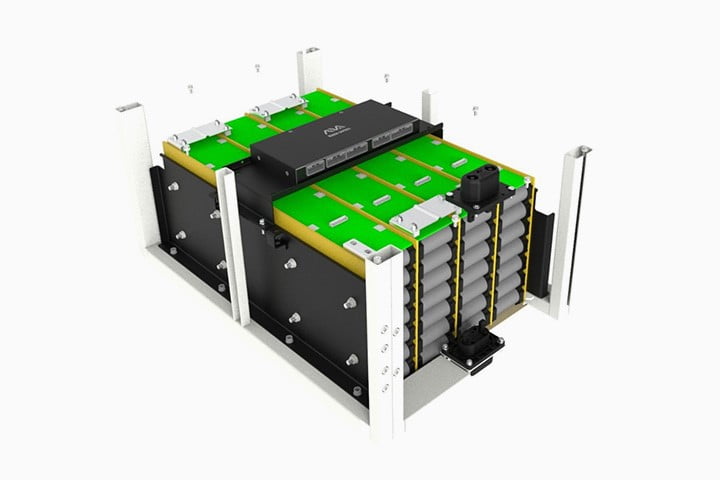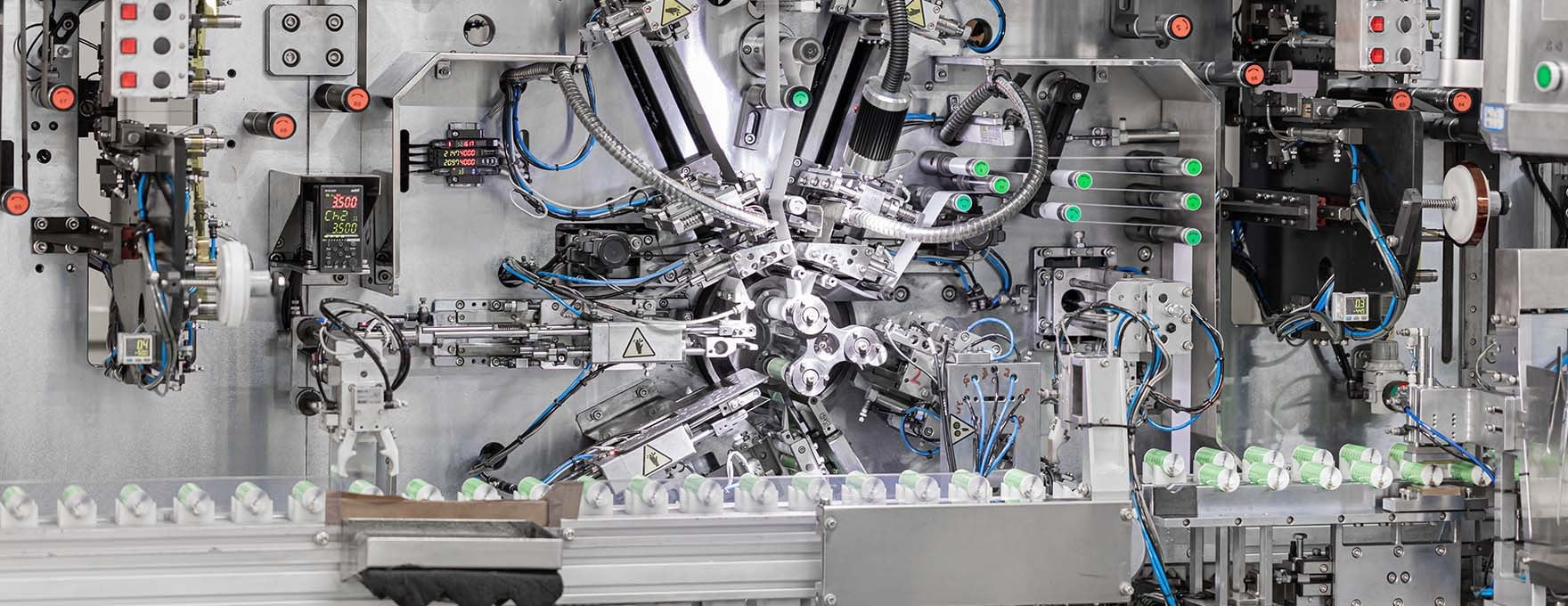What is a Solar Battery?
Let’s start with a simple answer to the question, “What is a solar battery?”
A solar battery is a device that you can add to your solar power system to store the excess electricity generated by your solar panels.
You can then use that stored energy to power your home at times when your solar panels don’t generate enough electricity, including nights, cloudy days, and during power outages.
The point of a solar battery is to help you use more of the solar energy you’re creating. If you don’t have battery storage, any excess electricity from solar power goes to the grid, which means you’re generating power and providing it to other people without taking full advantage of the electricity your panels create first.
The Science of Solar Batteries
Lithium-ion batteries are the most popular form of solar batteries currently on the market. This is the same technology used for Smartphone and other high-tech batteries.
Lithium-ion batteries work through a chemical reaction that stores chemical energy before converting it to electrical energy. The reaction occurs when lithium ions release free electrons, and those electrons flow from the negatively-charged anode to the positively-charged cathode.
This movement is encouraged and enhanced by lithium-salt electrolyte, a liquid inside the battery that balances the reaction by providing the necessary positive ions. This flow of free electrons creates the current necessary for people to use electricity.
When you draw electricity from the battery, the lithium ions flow back across the electrolyte to the positive electrode. At the same time, electrons move from the negative electrode to the positive electrode via the outer circuit, powering the plugged-in device.
Home solar power storage batteries combine multiple ion battery cells with sophisticated electronics that regulate the performance and safety of the whole solar battery system. Thus, solar batteries function as rechargeable batteries that use the power of the sun as the initial input that kick-starts the whole process of creating an electrical current.
Comparing Battery Storage Technologies
When it comes to solar battery types, there are two common options: lithium-ion and lead-acid. Solar panel companies prefer lithium-ion batteries because they can store more energy, hold that energy longer than other batteries, and have a higher Depth of Discharge (DoD).
Also known as DoD, Depth of Discharge is the percentage to which a battery can be used, related to its total capacity. For example, if a battery has a DoD of 95%, it can safely use up to 95% of the battery’s capacity before it needs to be recharged.
As mentioned earlier, battery manufacturers prefer lithium-ion battery technology for its higher DoD, reliable lifespan, ability to hold more energy for longer, and a more compact size. However, because of these numerous benefits, lithium-ion batteries are also more expensive compared to lead-acid batteries.
Lead-acid batteries (the same technology as most car batteries) have been around for years, and have been used widely as in-home energy storage systems for off-grid power options. While they are still on the market at pocket-friendly prices, their popularity is fading due to low DoD and shorter lifespan.
Coupling refers to how your solar panels are wired to your battery storage system, and the options are either direct current (DC) coupling or alternating current (AC) coupling. The main difference between the two lies in the path taken by the electricity that the solar panels create.
Solar cells create DC electricity, and that DC electricity must be converted into AC electricity before it can be used by your home. However, solar batteries can only store DC electricity, so there are different ways of connecting a solar battery into your solar power system.
With DC coupling, the DC electricity created by solar panels flows through a charge controller and then directly into the solar battery. There is no current change before storage, and conversion from DC to AC only occurs when the battery sends electricity to your home, or back out into the grid.
A DC-coupled storage battery is more efficient, because the electricity only needs to change from DC to AC once. However, DC-coupled storage typically requires a more complex installation, which can increase the initial cost and lengthen the overall installation timeline.
With AC coupling, DC electricity generated by your solar panels goes through an inverter first to be converted into AC electricity for everyday use by appliances in your home. That AC current can also be sent to a separate inverter to be converted back to DC current for storage in the solar battery. When it’s time to use the stored energy, the electricity flows out of the battery and back into an inverter to be converted back into AC electricity for your home.
With AC-coupled storage, electricity is inverted three separate times: once when going from your solar panels into the house, another when going from the home into battery storage, and a third time when going from battery storage back into the house. Each inversion does result in some efficiency losses, so AC coupled storage is slightly less efficient than a DC coupled system.
Unlike DC-coupled storage that only stores energy from solar panels, one of the big
advantages of AC coupled storage is that it can store energy from both solar panels and the grid. This means that even if your solar panels aren’t generating enough electricity to fully charge your battery, you can still fill the battery with electricity from the grid to provide you with backup power, or to take advantage of electricity rate arbitrage.
It’s also easier to upgrade your existing solar power system with AC-coupled battery storage, because it can just be added on top of an existing system design, instead of needing to be integrated into it. This makes AC coupled battery storage a more popular option for retrofit installations.
How Solar Batteries Work with a Solar Power System
This entire process starts with the solar panels on the roof generating power. Here is a step-by-step breakdown of what happens with a DC-coupled system:
- Sunlight hits the solar panels and the energy is converted to DC electricity.
- The electricity enters the battery and is stored as DC electricity.
- The DC electricity then leaves the battery and enters an inverter to be converted into AC electricity the home can use.
The process is slightly different with an AC-coupled system.
- Sunlight hits the solar panels and the energy is converted to DC electricity.
- The electricity enters the inverter to be converted into AC electricity the home can use.
- Excess electricity then flows through another inverter to change back into DC electricity that can be stored for later.
- If the house needs to use the energy stored in the battery that electricity must flow through the inverter again to become AC electricity.
How Solar Batteries Work with a Hybrid Inverter
If you have a hybrid inverter, a single device can convert DC electricity into AC electricity and can also convert AC electricity into DC electricity. As a result, you don’t need two inverters in your photovoltaic (PV) system: one to convert electricity from your solar panels (solar inverter) and another to convert electricity from the solar battery (battery inverter).
Also known as a battery-based inverter or hybrid grid-tied inverter, the hybrid inverter combines a battery inverter and solar inverter into a single piece of equipment. It eliminates the need to have two separate inverters in the same setup by functioning as an inverter for both the electricity from your solar battery and the electricity from your solar panels.
Hybrid inverters are growing in popularity because they work with and without battery storage. You can install a hybrid inverter into your battery-less solar power system during the initial installation, giving you the option of adding solar energy storage down the line.
Adding battery backup for solar panels is a great way of ensuring you get the most out of your solar power system. Here are some of the main benefits of a home solar battery storage system:
Your solar panel system can often produce more power than you need, especially on sunny days when no one is at home. If you don't have solar energy battery storage, the extra energy will be sent to the grid. If you participate in a net metering program, you can earn credit for that extra generation, but it’s usually not a 1:1 ratio for the electricity you generate.
With battery storage, the extra electricity charges up your battery for later use, instead of going to the grid. You can use the stored energy during times of lower generation, which reduces your reliance upon the grid for electricity.
Since your batteries can store the excess energy created by your solar panels, your home will have electricity available during power outages and other times when the grid goes down.
With solar panel battery storage, you can go green by making the most of the clean energy produced by your solar panel system. If that energy isn't stored, you will rely on the grid when your solar panels don’t generate enough for your needs. However, most grid electricity is produced using fossil fuels, so you will likely be running on dirty energy when drawing from the grid.
When the sun goes down and solar panels aren't generating electricity, the grid steps in to provide much-needed power if you don’t have any battery storage. With a solar battery, you’ll use more of your own solar electricity at night, giving you more energy independence and helping you keep your electric bill low.
A solar power battery is a 100% noiseless backup power storage option. You get to benefit from maintenance free clean energy, and don’t have to deal with the noise that comes from a gas-powered backup generator.
Understanding how a solar battery works is important if you’re thinking about adding solar panel energy storage to your solar power system. Because it operates like a large rechargeable battery for your home, you can take advantage of any excess solar energy your solar panels create, giving you more control over when and how you use solar energy.
Lithium-ion batteries are the most popular type of solar battery, and work through a chemical reaction that stores energy, and then releases it as electrical energy for use in your home. Whether you choose a DC-coupled, AC-coupled, or hybrid system, you may be able to increase the return on investment of your solar power system and reduce your reliance on the grid.
LiFePO4 battery stands for Lithium Iron Phosphate batteries. They are named so because the cathode material is LiFePO4. The anode is made of graphite. LiFePO4 batteries are a considerable improvement over conventional lithium-ion batteries. Additionally, their performance is leaps and bounds ahead of lead-acid batteries. These reasons have made LiFePO4 the most popular battery choice in recent years.
Different users will have different preferences when buying a LiFePO4 battery. Your decision should be based on factors like:
The capacity of a battery represents how many appliances it can power and for how long. It is measured in Watt hours (Wh). The capacity is the primary factor to consider and the main factor that drives up the LiFePO4 battery cost.
Users often get confused when they cannot see a Wh rating mentioned on the battery. Instead, they find voltage and Amp hours (Ah) ratings.
That is alright. You can find the Wh rating by multiplying voltage and amp hours.
Wh = V x Ah
For a 12V battery with a 320 Ah rating, the Wh will be:
Wh = 12 x 320 = 3840 Wh
To find out how much capacity you need, you can add the wattage of all the appliances you use. Then you can multiply it by the hours you want to run them without charging the battery. This will give you the minimum watt hours of the lithium-ion batteries you should buy.
For instance, if you want to run a total of 300W load for 10 hours, you require a minimum of:
Minimum Wh = 300 x 10 = 3000 Wh
Since the load or running time can increase or decrease, the required battery should have more capacity than the minimum Watt hours you require. Therefore, the 3840 Wh battery will be a good fit for the 3000 Wh minimum capacity.
Many users focus on ‘price’ as the deciding factor. However, a better factor to consider should be the value for money of the battery.
Lead acid batteries are the cheaper option in the market today. However, their lifespan is only one-tenth that of a LiFePO4 battery. While LiFePO4 batteries can last over 10 years, a lead acid battery will run out after a year or so. Additionally, there is always the risk of cheaper batteries running out while on the job.
Therefore, opt for value for money instead of the price as the deciding factor. It can save you countless trouble in the long run. This brings us to our next important criterion.
It is essential to consider how many years a battery will last. You can save money and buy lead-acid batteries if you want a short fix for a few months. However, most users do not want that. Instead, they require a long-term solution.
A LiFePO4 battery is the best option in terms of battery life. A good quality LiFePO4 battery will easily last upward of 10 years. AGM and conventional lithium-ion batteries can work well for three to four years.
Cycle life means the number of charge and discharge cycle that your battery can undergo. A longer cycle life means a battery will last longer. Batteries do not come with a suggestive lifespan on the box. However, they do mention a cycle life. Choose an option with a longer cycle life for a better return on investment.
Warranty is a good indicator of the build quality of the battery and its lifespan. Lead acid batteries come with a 6-month warranty. Therefore, they are workable for up to a year until they demand replacement. LiFePO4 battery is a whole different game.
You will find different kinds of warranty periods with different LiFePO4 manufacturers. Eco Tree Lithium is the leader in the game as it provides a warranty of an astonishing 6-year. You can expect the Lithium batteries to easily work for over 10 years with a warranty like that.
Depth of Discharge (DoD) is a significant factor that makes people switch from existing lead acid batteries to lithium iron phosphate batteries. Depth of discharge denotes the usable capacity of the battery.
For instance, the depth of discharge for lead acid batteries is 50%. Therefore, you can use these batteries to 50% of their capacity. After that, they will require charging. However, for Lithium’s LiFePO4 battery, the DoD is a whopping 100%. You can use LiFePO4 through the full rated capacity.
Here is an example for putting things in perspective. Suppose your capacity requirement is 200 Ah. You can meet this requirement with a 200 Ah LiFePO4 battery. However, you will need a 400 Ah battery capacity if opting for a lead acid battery due to its half depth of discharge.
Battery dimensions are important for applications like motorhomes. The battery compartments can accommodate a particular size battery bank. LiFePO4 battery has prefixed size groups to denote the standard size of the battery. Match the lithium battery group with your requirement.
Weight is not always on the priority list of important parameters. However, some users find having a lighter battery preferable. If that is the case, any lithium battery is a better buy over a lead acid battery. For instance, a lead acid battery pack of 500 Ah can weigh around 850 kg. The same job can be done by a 250 Ah lithium-ion battery weighing 210 kg. This means a considerable difference in weight.
The main differences come from the eliminated weight of lead plates and electrolytes. Additionally, lithium iron phosphate batteries have lighter electrodes.
Safety becomes essential when you operate your battery near life and property. There have been instances where lead acid battery leak fluids that cause corrosion of the battery and nearby appliances. Conventional lithium batteries have fire and explosion hazards with them. However, lithium iron phosphate batteries are made using very stable compounds of iron and phosphate. These will never explode or cause fire injury.
The voltage of the battery pack is important because it determines its usability. For instance, you cannot replace a 24V battery with a 48V battery and vice versa. Every type of voltage rating has a distinct application, advantage, and disadvantage. If you are replacing your old batteries, you will need to find old voltage rating and match new batteries with the same rating for a constant voltage.
Common voltage ratings are:
- 12V: Ideal for powering lights, science projects, and small-scale energy storage.
- 24V: Used for trolling motor, solar panels in motorhome, and electric scooters.
- 48V: Used for home solar batteries, data backups, motorhomes, etc.
All batteries are known for performance stuttering in extreme temperatures. Freezing conditions can lead to battering running flat. These batteries often do not recover once the temperature toll takes place. Therefore, find the optimal temperature range of the battery. Better yet, choose Eco Tree Lithium batteries with an inbuilt heater for cold weather.
Modern batteries come with many features that add to the convenient user experience. Take the case of this battery. It has a Bluetooth feature to check your battery stats remotely. You do not have to open the battery compartment. You don’t have to use a multimeter to check the voltage and current parameters. You can manage the battery remotely from a Bluetooth device.
Other secondary features can include LED indicators for the charging system. Having a handle to transport the battery is also a handy feature to have.
Always choose a LiFePO4 battery that comes with a BMS. A battery management system has a lot of safety protocols against potential hazards. All batteries are prone to irreversible overcharge and over-discharge damage. BMS protection measures cut off the circuit to eliminate any possibility of damage.
Modern energy technologies are pushing towards greener initiatives. It is recommended to choose an environmentally friendly battery option. For instance, cobalt-based batteries (like lithium cobalt oxide) are not environmentally friendly. This is because cobalt is rare and toxic in nature. LiFePO4 battery is one of the greenest battery out there.
Cobalt and lead come in toxic heavy metals category. These materials can cause health hazards if they come into human contact. Therefore, batteries that include these metals are considered unsafe. This includes all lead batteries. However, a lithium iron phosphate battery does not have any toxic substances in them.
Additionally, lead acid chemistry leads to the emission of toxic gases. You might be familiar with the pungent smell that often comes from lead batteries. Therefore, choose a battery that does not have any such risk. You will never need to vent lithium iron batteries because it releases no toxic gases.
Yes, you should always buy a LiFePO4 battery with a BMS. Lithium iron phosphate battery is a hefty investment. A BMS protects that investment from any harm. BMS will prolong the life of your battery significantly by monitoring every parameter.
Battery management systems come with surge protectors to avoid the harm of excessive currents. Additionally, many other circuits shield the battery from adverse situations. Many BMS also come with displays and relays that monitor data.
If you’re thinking of purchasing battery storage for solar panels, it is important to choose the right storage capacity to suit your needs. If you’re making use of solar energy throughout the day, then a larger battery won’t be of much use to you, as you’ll be decreasing the amount you can reasonably save. If you’re looking to capture all energy generated throughout the day, a solar battery that’s double the kilowatt peak (kWp) of your solar array will work best.
4kWp
A solar array with a 4kWp capacity will generate about 8kW of power throughout the day, which means that you’ll need battery storage for solar panels with a capacity of 8-9kW. This will allow you to capture the maximum amount of electricity that you’re generating. Any extra energy generated on top of this can then be sold back to the grid.
10 and 20kWp
10kW battery storage for solar panels will be needed for a 5kWp system, and at least 20kW will be needed for a 10kWp array. The rule of thumb for solar batteries is that you’ll require at least double the kilowatt peak of your solar panels in order to get the most benefit out of them. Anything less than this and you won’t have as much spare electricity to use when you need it. Anything more and your system will struggle to fully charge the battery, wasting the benefits you would otherwise receive.
Fortunately, some manufacturers offer stackable storage batteries, which can make it easier to increase your electricity capacity if you need to. Battery storage for solar panels is customisable to suit you. Some are floorstanding, while others are wall mounted. Being stackable, some batteries save on space and easily fit on top of each other into a neat stack. Your storage battery for solar panels can work to suit you and your needs.
Before you buy solar panels with battery storage, it’s important to consider what you’ll be using the electricity for. EVs can be charged using solar power, but this will reduce or completely consume any stored energy, not allowing you to use it for anything else.
The best way to figure out how much you might need or use is to get a smart meter. This will display how much electricity you use, helping you understand how battery storage for solar panels can help. If your typical usage would be covered (or mostly covered) by the captured electricity, then you will benefit from a solar battery.
Pros of Solar Batteries
- Lower utility bills
- Free electricity when needed
- Save money by exporting unused energy
- Power cut back-up
- Reduced carbon footprint
- Less dependence on the grid
Cons of Solar Batteries
- Big upfront cost
- Space needed
- Shorter lifespan than solar panels
Battery storage for solar panels helps you rely less on National Grid, which lowers your carbon footprint and protects you more easily from price hikes. By having your own reserve of energy already stored, you won’t have to pay anything to access it, and can even get money back from exporting it to the grid.
The biggest operating government solar panel incentive is the Smart Export Guarantee (SEG), which pays you for electricity you export to the grid. All large energy manufacturers are obligated to offer a price above £0, so most offer a few pence per kWh. However, Octopus Energy is leading the race with 15p/kWh for its customers. Other, agile export tariffs can offer you a better deal than this, so it pays to shop around. When it comes to making the most of your storage battery for solar panels, a good SEG rate can do wonders.
Another benefit to battery storage for solar panels is that, providing your system is operating and capturing energy as it should, you won’t have to worry about power cuts. Your stored energy is separate from the grid and you can tap into it when you need it.
Drawbacks
The biggest downside of battery storage for solar panels is the high price tag. Not only will you need to pay at least a few thousand pounds to purchase one, but their lifespan is not as long as the actual solar panels themselves. This means that you will have to replace a solar battery at least once before you need to replace your panels.
As well as this, you will need to think about where you’re going to store them. If there is no area inside, solar batteries can be fitted outside, but this can shorten their lifespan. Presented to the elements and weathering, externally fitted battery storage for solar panels don’t perform their best and run down more quickly.
The good news is that even if you want to install a solar panel system in your home, you don’t need to think about getting a solar battery at the same time. Battery storage for solar panels is designed to be fitted at any point in the installation process, so you can always buy them at a later date. Solar panels are worth benefitting from renewable energy, but battery storage is even more worthwhile so you can use as much of this energy as possible.
The storage capacity for solar batteries is only ever increasing as they are developed. Although the usable capacity will deplete over time, getting the most amount of storage for your household is crucial. Too much and you won’t benefit from the full amount, but not enough and you won’t see a visible reduction in your energy bills.
